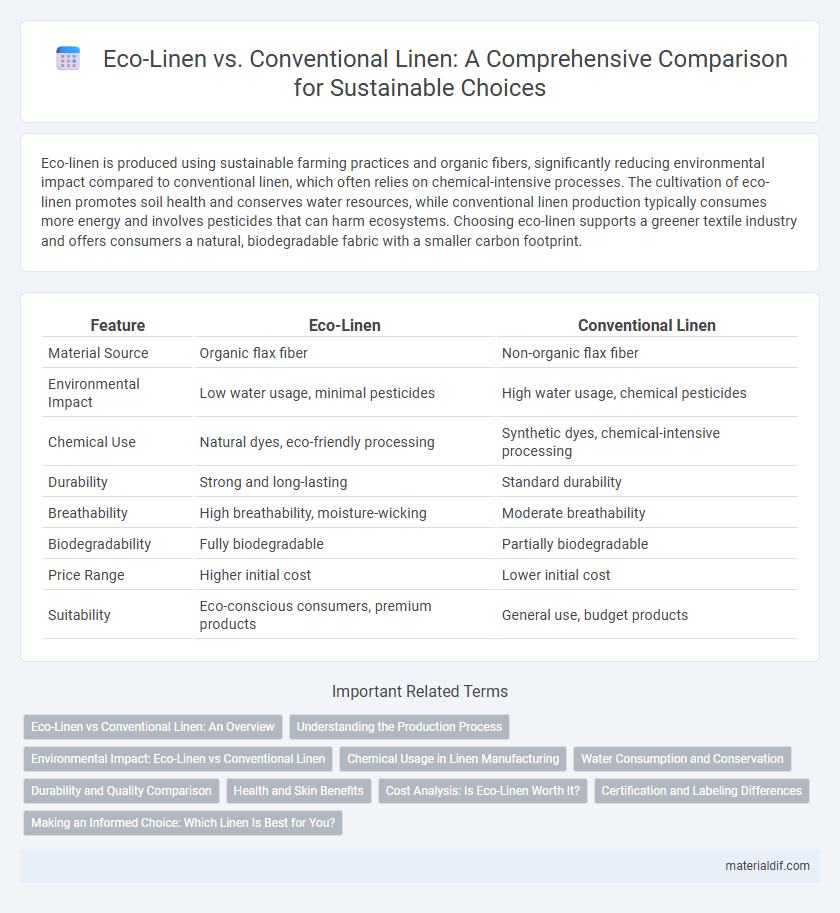Eco-linen is produced using sustainable farming practices and organic fibers, significantly reducing environmental impact compared to conventional linen, which often relies on chemical-intensive processes. The cultivation of eco-linen promotes soil health and conserves water resources, while conventional linen production typically consumes more energy and involves pesticides that can harm ecosystems. Choosing eco-linen supports a greener textile industry and offers consumers a natural, biodegradable fabric with a smaller carbon footprint.
Table of Comparison
| Feature | Eco-Linen | Conventional Linen |
|---|---|---|
| Material Source | Organic flax fiber | Non-organic flax fiber |
| Environmental Impact | Low water usage, minimal pesticides | High water usage, chemical pesticides |
| Chemical Use | Natural dyes, eco-friendly processing | Synthetic dyes, chemical-intensive processing |
| Durability | Strong and long-lasting | Standard durability |
| Breathability | High breathability, moisture-wicking | Moderate breathability |
| Biodegradability | Fully biodegradable | Partially biodegradable |
| Price Range | Higher initial cost | Lower initial cost |
| Suitability | Eco-conscious consumers, premium products | General use, budget products |
Eco-Linen vs Conventional Linen: An Overview
Eco-linen is crafted from organically grown flax, employing sustainable farming practices that reduce water usage and eliminate harmful pesticides, contrasting conventional linen produced with standard agricultural chemicals. This results in eco-linen offering superior environmental benefits, including lower carbon footprints and enhanced biodegradability. Consumers increasingly prefer eco-linen for its combination of durability, natural texture, and ecological responsibility.
Understanding the Production Process
Eco-linen is produced using environmentally friendly methods, including organic flax cultivation without synthetic pesticides or fertilizers, reducing soil and water contamination. Conventional linen, on the other hand, involves intensive use of chemicals during flax farming and retting processes, which can lead to higher environmental impact. The eco-linen production process emphasizes sustainability through natural retting techniques and energy-efficient manufacturing, promoting healthier ecosystems and reducing carbon footprint.
Environmental Impact: Eco-Linen vs Conventional Linen
Eco-linen is produced using sustainable farming practices that reduce water consumption by up to 60% compared to conventional linen, minimizing chemical pesticide and fertilizer use that often leads to soil degradation and water pollution. Conventional linen typically involves intensive resource use and emits higher levels of greenhouse gases throughout its cultivation and processing stages. Choosing eco-linen significantly lowers the environmental footprint by promoting biodiversity, reducing carbon emissions, and supporting regenerative agriculture.
Chemical Usage in Linen Manufacturing
Eco-linen manufacturing uses significantly fewer synthetic chemicals, relying on natural dyes and organic farming methods to reduce environmental impact. Conventional linen production often involves harsh chemical treatments such as bleaches and toxic pesticides, which contribute to soil degradation and water pollution. Choosing eco-linen supports sustainable agriculture and minimizes chemical residues in the final fabric.
Water Consumption and Conservation
Eco-linen requires significantly less water during cultivation compared to conventional linen, using up to 50% less water due to sustainable farming practices and rain-fed irrigation. Conventional linen production often depends on intensive irrigation, leading to higher water consumption and greater environmental strain. Water conservation in eco-linen not only reduces resource depletion but also minimizes pollution, supporting sustainable textile manufacturing.
Durability and Quality Comparison
Eco-linen offers superior durability compared to conventional linen due to its natural, chemical-free processing that maintains fiber strength and reduces breakage. The high-quality fibers in eco-linen result in longer-lasting fabric that resists wear and tear better than conventional linen, which often undergoes harsh chemical treatments weakening the material. Choosing eco-linen ensures a more sustainable and durable textile that retains its texture and structural integrity over time.
Health and Skin Benefits
Eco-linen, produced from organically grown flax without synthetic pesticides or fertilizers, reduces the risk of skin irritation and allergic reactions compared to conventional linen. Its natural fibers retain breathability and moisture-wicking properties, promoting better skin health by preventing bacterial buildup and overheating. The chemical-free processing of eco-linen ensures a hypoallergenic fabric suitable for sensitive skin, enhancing overall comfort and well-being.
Cost Analysis: Is Eco-Linen Worth It?
Eco-linen typically costs 20-30% more than conventional linen due to sustainable farming practices and reduced chemical use, which elevate production expenses. Although the initial investment is higher, eco-linen's durability and lower environmental impact can result in long-term savings and added value for eco-conscious consumers. Evaluating total cost of ownership including maintenance, lifespan, and ecological benefits reveals that eco-linen often justifies its premium price for sustainable textile markets.
Certification and Labeling Differences
Eco-linen is distinguished by certifications such as Global Organic Textile Standard (GOTS) and OEKO-TEX Standard 100, ensuring sustainable production, absence of harmful chemicals, and adherence to environmental criteria. Conventional linen often lacks these certifications, reflecting fewer guarantees regarding organic farming practices and chemical use. Labels on eco-linen provide transparent traceability and accountability, which conventional linen offerings frequently do not include.
Making an Informed Choice: Which Linen Is Best for You?
Eco-linen is made from organically grown flax using sustainable farming practices, resulting in lower water consumption and reduced chemical use compared to conventional linen, which relies on industrial farming methods. Choosing eco-linen supports environmental conservation efforts and often ensures better biodegradability, making it ideal for eco-conscious consumers seeking sustainable textiles. Conventional linen typically offers lower upfront costs but may involve harsher environmental impacts, so balancing durability, ecological footprint, and budget is essential when making an informed choice.
Eco-Linen vs Conventional Linen Infographic

 materialdif.com
materialdif.com